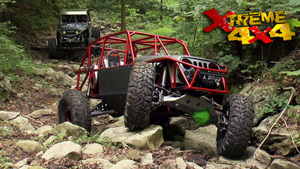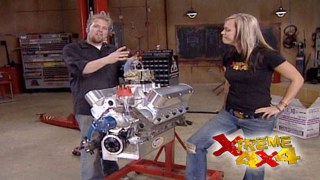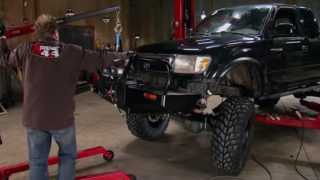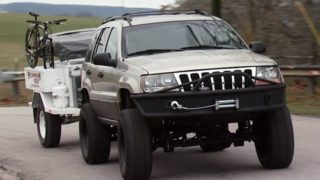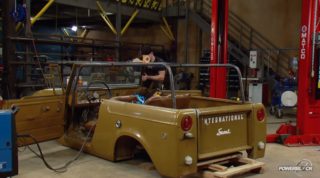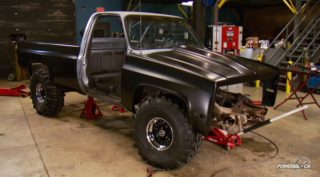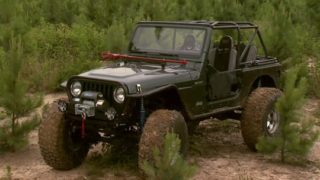More Trophy Truck Episodes
Xtreme 4x4 Builds
Want more content like this?
Join the PowerNation Email NewsletterParts Used In This Episode
Bilstein
9300 Coil Overs and 4-tube Bypass Shocks with a 2.56" body, 22mm case hardened and polished shaft, 1/2" uniball joints with the optional dirt free receiving ends.
Howe Performance
2 3/4" power assisted Truggy Rack steering assembly wih high flow control valve and quick release hub and steering wheel. Plus, an additional mechanical steering shaft just in case there is a loss of hydrolic hoses or fluid, the steering is still capable, just without the power assist.
Hypercoils
Coil Springs rated differently for all four corners - Front: upper - 10" 350 lb/in; lower - 16" 500 lb/in. Rear: upper - 16" 250 lb/in; lower - 16" 350 lb/in.
Summit Racing
15gal aluminum race fuel cell with -8 feed and return.
Episode Transcript
Today on Xtreme 4x4. It's a smorgasbord in the shop from cutters to welders, bare bones suggestions on what you need to get fabricating.
Nina Curry who's on fire in the core series. See the sickest suspension package ever plus a gearhead trick that would make Martha Stewart proud.
Um
Good.
You know, one of the cool things about being involved in off roading is that as a group, we honestly value function over form. Now, that's not to say that guys aren't building some great looking trail rigs. We see them all the time, but it's more important how they act on the trail because as a rule, it's gotta work good first and look good. Second,
one of the coolest things is a hardcore race truck, like our core prow
chassis. These things are purpose built race vehicles and you have to follow the rule book. When you put them together,
there's not a lot of room for individuality to set them apart from the crowd, but just by the very nature of the parts that go in these things, they're rolling works of art,
800 horsepower sculptures that can run 100 miles an hour over wild short course terrain, a
motor sport that's best described as ultimate fighting with trucks.
And today we're gonna get our prow
race truck one step closer to being on the track and it's gonna start with a part that truly fits the saying. Looks just as good as they work. And those are shocks for our truck. We're gonna be using Bill Stein 9300 series coil overs and a matching 42 bypass shock on all four corners. And the shock body itself is 2.65 inches
in diameter. It has a 22 millimeter case hardened and polished shaft. Now, the reservoirs are made at a seamless tubing
and not only do they allow for more shock travel in the body, it actually helps to cool the fluid because of the heat dissipation.
At either end, we have a heavy duty half inch uni ball and we opted for their dirt and dust free receiving ends just to make these shocks last a long time on the track.
Now, bypass shocks are cool no matter what vehicle they're on. Not just because they look like a nickel plated submarine control room, but because of how they work, they allow you some great fine tuning in your suspension.
Now, imagine you took this race truck out to a track that had a series of whoops, you had to get through just before you hit a big jump and yes, core trucks can fly
so to fine tune our suspension for that kind of terrain. We want it soft during the whoop section or the first
5 to 10 inches of travel
and once the truck gets in the air and the suspension fully unloads and then completely compresses need to stiffen up near the end. So it doesn't bottom out completely.
We do that by adjusting our bypass tubes. If we open up this fitting on the lower bypass tube,
the shock will actually be soft as the piston moves from here to here because more of the oil goes through the bypass tube than through the valving inside the shock itself. But
the shock valving crosses this tube and blocks it off. Then all that shock oil has to go through the valve itself. And by closing off the upper bypass tube to let very little oil through, we force the shock to get stiffer from here to here. So in essence, we can fine tune the shock in different parts of its travel and we can do the same on the rebound or the droop out by adjusting the other two bypass ports, but that's not the only place we can fine tune this suspension.
Now, on our coil overs, we're going to be installing hyper coal coil springs of different spring rates. Now, the front upper is a 10 inch, 350 pound per inch spring mounted over a 16 inch 500 pound spring. Now the rear are 216 inches, a 250 over a 350. Now, we stagger these spring rates for a very specific reason. When you combine the softer spring
and the stiffer spring in a stack on the shock, it actually works softer than their combined spring rate.
What we wanna do is be able to pick where the suspension gets stiff. So we wanna isolate this spring out of the system. We do that by changing these adjustable lock nuts on the threaded body itself as the sliding spring collar comes up and compresses the upper spring, it hits the lock and stops and then all,
all the load on the suspension is going to be carried by the stiffer lower spring. This is gonna allow us to choose where the suspension starts to get stiff and we can also do the same moving the adjustment locks onto the bottom side of the spring color and we can adjust how fast the suspension droops out. Now, this type of setup along with our bypass shocks allow us to fine tune the suspension for any track condition or any type of race
steering on an off road race truck is very specialized.
We're using a how two and three quarter inch power assisted trie
rack,
the high flow control valve mounts inside the cockpit and the quick release hub and steering wheel will be installed later.
Now, this type of steering is ideal for an off road race truck. Not only do we have the benefits of the hydraulic cylinder giving us power assist to the wheels, but we still have a mechanical attachment that will go up to the steering wheel itself.
Now, you've seen us install full hydraulic systems before on our off road buggies and trail trucks. But the benefit of this is if we ever blow a line or lose all the fluid, we'll still have full control of the steering system. We just won't have the power system
coming up. His family name is synonymous with bulletproof rear ends. But his pro light driver, Casey Curry tough enough to win a core championship. Find out after the break,
there's nothing quite like being a rookie who earns the respect of the veterans that surround him. And in championship off-road racing, Casey Curry is a star in the making.
Rena
grieves Taylor and Douglas have long dominated the core series. This is my life. This is my passion and there isn't anything better because that's why I'm still doing it. Closing in on the veterans is a youth movement that dreams of one day knocking off the big dogs. There's a whole separate race going on
among the egos of these young kids. One kid has already caught the attention of the ruling class.
Casey Curry, Casey's doing good guys like Casey Curry coming into the sport is really gonna help the level of competition continue to grow. I'm a real racer
after achieving success in pro motorcycle racing. Casey Curry walked away to pursue his true passion, growing up racing motorcycles, all my life, all I ever really wanted to do was race trucks. You know, I don't care if it's in the desert or on the shore because I really love racing trucks. It's beyond words. I mean, it's incredible. His family is been in the off road parts business since 1959.
So that passion for racing comes early when you're occurring,
been
doing it since
you were
a
go kart with a five years old.
He never
got out of a
system. Where would he get a crazy idea?
Rampa Frank is there to give sage advice. You know, he's 70 something years old. He's still racing. He brings a lot of experience to this pit while Casey and his father enjoy a bond that extends far from the racetrack. You know, we're together 24 hours a day, seven days a week. This is what we do and this is what we live for. He gives me all the support that I need. We're a team that can't lose. You know, me and my dad
close when I was racing, he was there looking over my shoulder
and I think that helped prepare me a lot for
helping Kse. Just kind of looking over his shoulder and making sure he's making the right moves, the high expectations that come with the curry name is going to rattle this rookie. Yeah, I feel that I have an added pressure just because we are in the business ourselves. But at the same time, I feel that I'm fast enough to run up front.
Most racers dream of running out
in the pro four or two wheel drive classes
when the 22 year old chose to run in the restricted Pro lights. He shocked the establishment. The reason I ran the pro light class is because I feel the Pro Light class is more towards the
younger generation. There's more kids driving a frontier or a Ford Ranger than any other truck. I'm so young and I'm the young gun in the sport that hey, I need to be where my crowd is on race day. The crowds arrive early to meet the kid who's on the fast track to stardom
when people are asking for my autograph, I don't feel like in anybody, you know. So to me, it's, it's awesome
with the hype pegged in overdrive. Casey was still in search of his first podium at the second to last round. The biggest lesson I've learned is everything takes time. Nothing comes overnight. I think it was probably 10 degrees more competitive than we ever imagined. Six
place had been his best finish,
but the crew knows it won't be long. He's going to be a good driver. He goes full
throttle for everything. It's crazy
at
Chula Vista Raceway south of San Diego. Casey. Curry shut down the doubters on the last lap. He made the pass to earn his first career podium.
This is nothing. You know, this is
third place. I'm ready to do more. I feel that this is it, man. This is
the bottom of the totem pole. Now it's all uphill from here.
It was an emotional day as Casey's father watched his boy
become a man.
Couldn't hardly be prouder
right now.
Nice
to see him have it.
Oh,
nice to see him. Earn. It makes all the difference
time now for an Xtreme 4x4 tech tip.
And we all like to carry spare parts with us when we head out into the trail and into the woods.
But the hard part is finding a good way to carry these things. Little parts always get lost and you certainly don't want to throw a bearing that's all packed with grease just in the bottom of the toolbox. Well, if you grab a vacuum sealer from your kitchen, you're gonna go ahead and you can have a sealed up pouch that not only is waterproof, it'll actually pack the bearing for you.
Now, we'll have a prepacked bearing ready to replace on the axle if we need it.
And the nice thing is, is it's waterproof and you can just throw it in the toolbox but don't stop with bearings. How many times have we tore up an axle joint or a U joint on the trail and then not had a strap kit with all the nuts and washers handy to replace it. Take all those parts, throw them in a bag
seal that up too.
You'll have all the parts you need
in one place.
Welcome back to Xtreme 4x4 and our core prow
race truck build. Now, if you remember we're putting this truck together for the guys over at championship off road racing to use as a promotional vehicle. But at the same time, we're building it as a memorial to a great racer. Jason Baldwin, we'll be slapping the big 66 on the
of it before we're done
now, just because the show truck doesn't mean we're holding back on any of the hardcore race parts. And upfront, we've already installed our bill, Stein Coal over shocks and bypasses are how trucky rack and we've put in all the gusts that's required by the sanctioning body to make this a legal race truck. And now we can work on the fuel system.
We're using a summit racing 15 gallon fuel cell. It's an aluminum race version with dash eight feed and return.
Probably one of the coolest things about working on a full on race truck like this
is, they truly are a 100% custom. I mean, this thing started life as a pile of tube and some flat plate. There's no such thing as a bolt on part when you're talking about a race chassis.
And that leads us to a question. I get asked a lot fab tools if I'm gonna get started building my own stuff. What do I need to buy? Well, let's have a look.
Now, we're not gonna spend a lot of time talking about hand tools or the right jack or stand to have in your garage. Because if you're doing any of these projects, you probably already have all that stuff. Instead, we're gonna concentrate on big ticket items that require a serious investment. And the first thing we're gonna talk about are welders. Now, since the majority of all of our projects are based on a carbon steel. A mi
welder is your first choice when it comes to welding.
But then you have to make a decision. 100 and 10 or a 220 volt welder. Now, obviously, the 220 volt welder is the better choice to make because capable of welding a lot thicker steel, but a lot of you don't have a plug like that in your garage. You're gonna have to have it installed. Now, some 110 volt welders can weld up to 3/16 plate. But you're gonna remember every time you're welding that to an axle tube, you're still welding to half inch parent metal. So the 220 volt mig welder is the great choice is your first welder. But remember to factor in the cost of having the plug installed in your garage, so you can use it when you get home. Now, a tig welder is a very specialized piece of equipment. And unless you're gonna break out and start doing a lot of aluminum work, the money that you would invest in this machine is honestly better spent elsewhere.
Now, with the welder in the garage, you're ready to start building. But obviously, first, you need to cut the steel to the right shape. Now, for straight cuts, you can go ahead and just use a common everyday chop saw like this one or even just a cut off tool with a wheel mounted to it.
But when it comes to complex shapes like brackets and tabs, you're gonna have to use something different. Now, when you wanna make a link mount like this, a lot of people just go ahead spend their money on a good plasma cutter, but I honestly prefer to have a good band saw instead.
And to prove my point, I'm gonna build two of these link mounts, one with each tool
with the link mount design traced out on some 316 steel. We'll cut it with the plasma cutter first to the basic shape
and then spend time grinding
and grinding and grinding.
Now, on the banda,
the sheep can simply be trimmed
with a very little grinding to achieve a finished shape.
Now, there's very little difference between our two finished pieces.
The only main thing is we've had to spend more time grinding on the plasma cut version to remove all the slag. So it's ready to be welded. Now, that's not to say that a bandsaw is a small cost investment. They aren't, they're expensive. I checked it online. A good used one
run. You at least 1000 bucks.
But a plasma cutter is obviously less than that,
but it doesn't work alone. You gotta remember. You're gonna need a good compressed air source to run it as well as, again, that 220 volt plug.
But there's one other way to make the same bracket. And that's using the good old
acetylene torch,
old school style.
When I started working in the trade. If you wanted to cut metal, the torch was your only option. In
my opinion, it's still one of the most versatile fab tools to have and the cheapest
now I know what you're thinking. He's got all these tools. So it's easy to make this kind of stuff. But we just showed you three different ways to make these brackets and one of them was really cheap, just a standard set of torches that the kit's gonna run you about 350 bucks. Now, if it was me outfitting my shop for the very first time I'd start with a set of torches and later on I'd upgrade and buy a good band saw even if it was used to last forever. And then after that, get a plasma cutter and then you got a tool for just about every job.
Welcome back. To Xtreme 4x4 where we're taking a look at some of the tools you need to build certain parts for your projects
and you don't want to spend all your time just cutting out brackets from flat plate. You wanna build something. That's why you buy these tools in the first place. So we're gonna build a bumper using this mock up frame rail section. I've set these two pieces at 29.5 inches apart, which is the same as a Toyota mini truck. And I'm gonna build two very different bumpers to give you an idea of what kind of tools you need to build each one
flat plate design bumper is very popular in rock crawling and it can be built using all the tools we used earlier,
the torches,
the grinder
and the weather,
a tube bumper always looks better with bends. So you're gonna need to add a bender to your tool list,
but let's face it. Most of us will eventually be building a cage or a chassis.
So you're gonna be buying a vendor sooner or later.
Uh
Hopefully this answered the question for you guys about what kind of fab tools are great to start out with simple plate bumpers. You can get by with a good set of torches and a welder and a grinder. Obviously, when you start working with tube, it gets more complicated.
Now, the next time we have a core truck in here, we're gonna be taking care of the drive train in that truck and you're not gonna wanna miss that because that thing is gonna be a beast.
Show Full Transcript
Nina Curry who's on fire in the core series. See the sickest suspension package ever plus a gearhead trick that would make Martha Stewart proud.
Um
Good.
You know, one of the cool things about being involved in off roading is that as a group, we honestly value function over form. Now, that's not to say that guys aren't building some great looking trail rigs. We see them all the time, but it's more important how they act on the trail because as a rule, it's gotta work good first and look good. Second,
one of the coolest things is a hardcore race truck, like our core prow
chassis. These things are purpose built race vehicles and you have to follow the rule book. When you put them together,
there's not a lot of room for individuality to set them apart from the crowd, but just by the very nature of the parts that go in these things, they're rolling works of art,
800 horsepower sculptures that can run 100 miles an hour over wild short course terrain, a
motor sport that's best described as ultimate fighting with trucks.
And today we're gonna get our prow
race truck one step closer to being on the track and it's gonna start with a part that truly fits the saying. Looks just as good as they work. And those are shocks for our truck. We're gonna be using Bill Stein 9300 series coil overs and a matching 42 bypass shock on all four corners. And the shock body itself is 2.65 inches
in diameter. It has a 22 millimeter case hardened and polished shaft. Now, the reservoirs are made at a seamless tubing
and not only do they allow for more shock travel in the body, it actually helps to cool the fluid because of the heat dissipation.
At either end, we have a heavy duty half inch uni ball and we opted for their dirt and dust free receiving ends just to make these shocks last a long time on the track.
Now, bypass shocks are cool no matter what vehicle they're on. Not just because they look like a nickel plated submarine control room, but because of how they work, they allow you some great fine tuning in your suspension.
Now, imagine you took this race truck out to a track that had a series of whoops, you had to get through just before you hit a big jump and yes, core trucks can fly
so to fine tune our suspension for that kind of terrain. We want it soft during the whoop section or the first
5 to 10 inches of travel
and once the truck gets in the air and the suspension fully unloads and then completely compresses need to stiffen up near the end. So it doesn't bottom out completely.
We do that by adjusting our bypass tubes. If we open up this fitting on the lower bypass tube,
the shock will actually be soft as the piston moves from here to here because more of the oil goes through the bypass tube than through the valving inside the shock itself. But
the shock valving crosses this tube and blocks it off. Then all that shock oil has to go through the valve itself. And by closing off the upper bypass tube to let very little oil through, we force the shock to get stiffer from here to here. So in essence, we can fine tune the shock in different parts of its travel and we can do the same on the rebound or the droop out by adjusting the other two bypass ports, but that's not the only place we can fine tune this suspension.
Now, on our coil overs, we're going to be installing hyper coal coil springs of different spring rates. Now, the front upper is a 10 inch, 350 pound per inch spring mounted over a 16 inch 500 pound spring. Now the rear are 216 inches, a 250 over a 350. Now, we stagger these spring rates for a very specific reason. When you combine the softer spring
and the stiffer spring in a stack on the shock, it actually works softer than their combined spring rate.
What we wanna do is be able to pick where the suspension gets stiff. So we wanna isolate this spring out of the system. We do that by changing these adjustable lock nuts on the threaded body itself as the sliding spring collar comes up and compresses the upper spring, it hits the lock and stops and then all,
all the load on the suspension is going to be carried by the stiffer lower spring. This is gonna allow us to choose where the suspension starts to get stiff and we can also do the same moving the adjustment locks onto the bottom side of the spring color and we can adjust how fast the suspension droops out. Now, this type of setup along with our bypass shocks allow us to fine tune the suspension for any track condition or any type of race
steering on an off road race truck is very specialized.
We're using a how two and three quarter inch power assisted trie
rack,
the high flow control valve mounts inside the cockpit and the quick release hub and steering wheel will be installed later.
Now, this type of steering is ideal for an off road race truck. Not only do we have the benefits of the hydraulic cylinder giving us power assist to the wheels, but we still have a mechanical attachment that will go up to the steering wheel itself.
Now, you've seen us install full hydraulic systems before on our off road buggies and trail trucks. But the benefit of this is if we ever blow a line or lose all the fluid, we'll still have full control of the steering system. We just won't have the power system
coming up. His family name is synonymous with bulletproof rear ends. But his pro light driver, Casey Curry tough enough to win a core championship. Find out after the break,
there's nothing quite like being a rookie who earns the respect of the veterans that surround him. And in championship off-road racing, Casey Curry is a star in the making.
Rena
grieves Taylor and Douglas have long dominated the core series. This is my life. This is my passion and there isn't anything better because that's why I'm still doing it. Closing in on the veterans is a youth movement that dreams of one day knocking off the big dogs. There's a whole separate race going on
among the egos of these young kids. One kid has already caught the attention of the ruling class.
Casey Curry, Casey's doing good guys like Casey Curry coming into the sport is really gonna help the level of competition continue to grow. I'm a real racer
after achieving success in pro motorcycle racing. Casey Curry walked away to pursue his true passion, growing up racing motorcycles, all my life, all I ever really wanted to do was race trucks. You know, I don't care if it's in the desert or on the shore because I really love racing trucks. It's beyond words. I mean, it's incredible. His family is been in the off road parts business since 1959.
So that passion for racing comes early when you're occurring,
been
doing it since
you were
a
go kart with a five years old.
He never
got out of a
system. Where would he get a crazy idea?
Rampa Frank is there to give sage advice. You know, he's 70 something years old. He's still racing. He brings a lot of experience to this pit while Casey and his father enjoy a bond that extends far from the racetrack. You know, we're together 24 hours a day, seven days a week. This is what we do and this is what we live for. He gives me all the support that I need. We're a team that can't lose. You know, me and my dad
close when I was racing, he was there looking over my shoulder
and I think that helped prepare me a lot for
helping Kse. Just kind of looking over his shoulder and making sure he's making the right moves, the high expectations that come with the curry name is going to rattle this rookie. Yeah, I feel that I have an added pressure just because we are in the business ourselves. But at the same time, I feel that I'm fast enough to run up front.
Most racers dream of running out
in the pro four or two wheel drive classes
when the 22 year old chose to run in the restricted Pro lights. He shocked the establishment. The reason I ran the pro light class is because I feel the Pro Light class is more towards the
younger generation. There's more kids driving a frontier or a Ford Ranger than any other truck. I'm so young and I'm the young gun in the sport that hey, I need to be where my crowd is on race day. The crowds arrive early to meet the kid who's on the fast track to stardom
when people are asking for my autograph, I don't feel like in anybody, you know. So to me, it's, it's awesome
with the hype pegged in overdrive. Casey was still in search of his first podium at the second to last round. The biggest lesson I've learned is everything takes time. Nothing comes overnight. I think it was probably 10 degrees more competitive than we ever imagined. Six
place had been his best finish,
but the crew knows it won't be long. He's going to be a good driver. He goes full
throttle for everything. It's crazy
at
Chula Vista Raceway south of San Diego. Casey. Curry shut down the doubters on the last lap. He made the pass to earn his first career podium.
This is nothing. You know, this is
third place. I'm ready to do more. I feel that this is it, man. This is
the bottom of the totem pole. Now it's all uphill from here.
It was an emotional day as Casey's father watched his boy
become a man.
Couldn't hardly be prouder
right now.
Nice
to see him have it.
Oh,
nice to see him. Earn. It makes all the difference
time now for an Xtreme 4x4 tech tip.
And we all like to carry spare parts with us when we head out into the trail and into the woods.
But the hard part is finding a good way to carry these things. Little parts always get lost and you certainly don't want to throw a bearing that's all packed with grease just in the bottom of the toolbox. Well, if you grab a vacuum sealer from your kitchen, you're gonna go ahead and you can have a sealed up pouch that not only is waterproof, it'll actually pack the bearing for you.
Now, we'll have a prepacked bearing ready to replace on the axle if we need it.
And the nice thing is, is it's waterproof and you can just throw it in the toolbox but don't stop with bearings. How many times have we tore up an axle joint or a U joint on the trail and then not had a strap kit with all the nuts and washers handy to replace it. Take all those parts, throw them in a bag
seal that up too.
You'll have all the parts you need
in one place.
Welcome back to Xtreme 4x4 and our core prow
race truck build. Now, if you remember we're putting this truck together for the guys over at championship off road racing to use as a promotional vehicle. But at the same time, we're building it as a memorial to a great racer. Jason Baldwin, we'll be slapping the big 66 on the
of it before we're done
now, just because the show truck doesn't mean we're holding back on any of the hardcore race parts. And upfront, we've already installed our bill, Stein Coal over shocks and bypasses are how trucky rack and we've put in all the gusts that's required by the sanctioning body to make this a legal race truck. And now we can work on the fuel system.
We're using a summit racing 15 gallon fuel cell. It's an aluminum race version with dash eight feed and return.
Probably one of the coolest things about working on a full on race truck like this
is, they truly are a 100% custom. I mean, this thing started life as a pile of tube and some flat plate. There's no such thing as a bolt on part when you're talking about a race chassis.
And that leads us to a question. I get asked a lot fab tools if I'm gonna get started building my own stuff. What do I need to buy? Well, let's have a look.
Now, we're not gonna spend a lot of time talking about hand tools or the right jack or stand to have in your garage. Because if you're doing any of these projects, you probably already have all that stuff. Instead, we're gonna concentrate on big ticket items that require a serious investment. And the first thing we're gonna talk about are welders. Now, since the majority of all of our projects are based on a carbon steel. A mi
welder is your first choice when it comes to welding.
But then you have to make a decision. 100 and 10 or a 220 volt welder. Now, obviously, the 220 volt welder is the better choice to make because capable of welding a lot thicker steel, but a lot of you don't have a plug like that in your garage. You're gonna have to have it installed. Now, some 110 volt welders can weld up to 3/16 plate. But you're gonna remember every time you're welding that to an axle tube, you're still welding to half inch parent metal. So the 220 volt mig welder is the great choice is your first welder. But remember to factor in the cost of having the plug installed in your garage, so you can use it when you get home. Now, a tig welder is a very specialized piece of equipment. And unless you're gonna break out and start doing a lot of aluminum work, the money that you would invest in this machine is honestly better spent elsewhere.
Now, with the welder in the garage, you're ready to start building. But obviously, first, you need to cut the steel to the right shape. Now, for straight cuts, you can go ahead and just use a common everyday chop saw like this one or even just a cut off tool with a wheel mounted to it.
But when it comes to complex shapes like brackets and tabs, you're gonna have to use something different. Now, when you wanna make a link mount like this, a lot of people just go ahead spend their money on a good plasma cutter, but I honestly prefer to have a good band saw instead.
And to prove my point, I'm gonna build two of these link mounts, one with each tool
with the link mount design traced out on some 316 steel. We'll cut it with the plasma cutter first to the basic shape
and then spend time grinding
and grinding and grinding.
Now, on the banda,
the sheep can simply be trimmed
with a very little grinding to achieve a finished shape.
Now, there's very little difference between our two finished pieces.
The only main thing is we've had to spend more time grinding on the plasma cut version to remove all the slag. So it's ready to be welded. Now, that's not to say that a bandsaw is a small cost investment. They aren't, they're expensive. I checked it online. A good used one
run. You at least 1000 bucks.
But a plasma cutter is obviously less than that,
but it doesn't work alone. You gotta remember. You're gonna need a good compressed air source to run it as well as, again, that 220 volt plug.
But there's one other way to make the same bracket. And that's using the good old
acetylene torch,
old school style.
When I started working in the trade. If you wanted to cut metal, the torch was your only option. In
my opinion, it's still one of the most versatile fab tools to have and the cheapest
now I know what you're thinking. He's got all these tools. So it's easy to make this kind of stuff. But we just showed you three different ways to make these brackets and one of them was really cheap, just a standard set of torches that the kit's gonna run you about 350 bucks. Now, if it was me outfitting my shop for the very first time I'd start with a set of torches and later on I'd upgrade and buy a good band saw even if it was used to last forever. And then after that, get a plasma cutter and then you got a tool for just about every job.
Welcome back. To Xtreme 4x4 where we're taking a look at some of the tools you need to build certain parts for your projects
and you don't want to spend all your time just cutting out brackets from flat plate. You wanna build something. That's why you buy these tools in the first place. So we're gonna build a bumper using this mock up frame rail section. I've set these two pieces at 29.5 inches apart, which is the same as a Toyota mini truck. And I'm gonna build two very different bumpers to give you an idea of what kind of tools you need to build each one
flat plate design bumper is very popular in rock crawling and it can be built using all the tools we used earlier,
the torches,
the grinder
and the weather,
a tube bumper always looks better with bends. So you're gonna need to add a bender to your tool list,
but let's face it. Most of us will eventually be building a cage or a chassis.
So you're gonna be buying a vendor sooner or later.
Uh
Hopefully this answered the question for you guys about what kind of fab tools are great to start out with simple plate bumpers. You can get by with a good set of torches and a welder and a grinder. Obviously, when you start working with tube, it gets more complicated.
Now, the next time we have a core truck in here, we're gonna be taking care of the drive train in that truck and you're not gonna wanna miss that because that thing is gonna be a beast.







